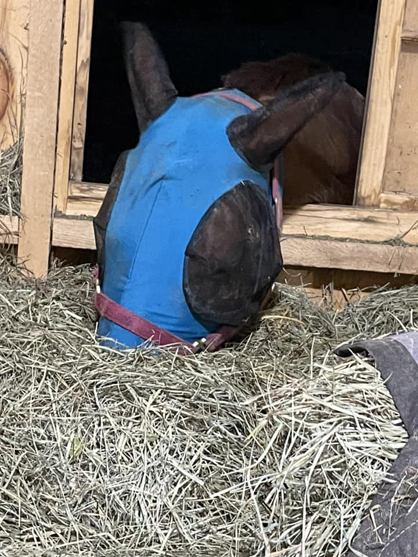
Know Thy Forage: Ten Forage-Related Terms That May Be New To You
By Kentucky Equine Research Staff
Every aspect of equestrianism features a language of its own. Coat color enthusiasts can define every shade and nuance; tack specialists can accurately describe a barrel full of bits using a specialized vocabulary. For nutrition aficionados, a robust wordlist is also in play. Just as forage is the foundation of a horse’s diet, let’s review some common forage-related terms that may be useful in everyday stallside conversation.
Before we begin, a word about “forage.” While some people stumble over this term, forage simply means the edible parts of plants, other than separated grain, that serves as feed for horses, or that can be harvested for feeding.* Examples of forage include pasture, hay, haylage, hay pellets, and hay cubes.
“Forage quality” refers to characteristics that make forage valuable to horses as a source of nutrients, typically the combination of energy that determines its potential to fuel work in performance horses, growth in youngsters, and milk production in broodmares, and other essential nutrients such as protein, vitamins, and minerals.
Without further ado, do you know these common forage terms?
Cool-season grasses – grass species best adapted to growth during cool, moist periods of the year, commonly having temperature optimums of 59-77° F (15-25° C).
Fescue – a cool-season grass often used in forage stands for horses. Tall varieties are sometimes infected with a fungus, specifically the endophyte Acremonium coenophialum, that lives symbiotically with the plant. Exposure of horses to endophyte-infected tall fescue can elicit a toxic response, called fescue toxicity, which is especially problematic in pregnant mares and characterized by increased gestation length, lack of milk, placental abnormalities, and mare or foal death.
Fiber – a component of plant cell walls that provides strength and structure to the plant. As a plant matures, the fibrous component increases and lengthens to support the plant. Fiber is considered a structural carbohydrate. Horses are capable of digesting fiber due to microbial fermentation that occurs in the hindgut; because of this physiological feature, horses require fiber in their diets for optimal health.
Haylage – product resulting from ensiled forage with about 45% moisture in the absence of oxygen.
Legume – a large and agriculturally important family of flowering plants that produce seed pods; when produced and harvested under similar conditions, legume hays are generally higher in protein, energy, and certain minerals than grass hays.
Long-stemmed forage – this term speaks specifically to the physical length of the plant material or stems as it is presented to the horse. Long-stemmed forages include hay and some pasture plants. When forage is chopped or ground and formed into cubes or pellets, it is no longer considered long-stemmed forage.
Maturity – an arbitrary term to indicate the adult (or older) stages of plant development or its readiness to harvest. In general, mature forages, especially overmature plants, have less nutritional value than younger plants.
Overgrazing – grazing horses on a given area that, if continued to the end of the planned grazing period, will result in less than satisfactory performance (weight loss, etc.) or less than satisfactory pasture forage production; not to be confused with overstocking, which is horses on a given area that will result in overuse if continued to the end of the planned grazed period. Continued overstocking often leads to overgrazing.
Ration – perhaps not specifically related to forage, but a ration is the total amount of feed allotted to one animal for a 24-hour period.
Warm-season grass – grass species best adapted to growth during the warmer part of the year and usually dormant during cold weather or injured by it; commonly having temperature optimums of 80-95° F (27-35° C).
*Glossary of Crop Science Terms. 1992. Crop Science Society of America.

Recently Added
- EC Photo of the Day – When You Are Together December 27, 2025
- Preparing for a Barn Disaster from University of Minnesota Extension December 26, 2025
- 2026 Arizona Sun Circuit NSBA Futurity Class Offerings December 26, 2025
- EC Photo of the Day – Your Next 2YO Prospect December 26, 2025
- On The Cover – TB Mr Hollywood December 26, 2025
- EC Christmas Photo of the Day – A Decade of Holiday Cheer December 25, 2025
- Merry Christmas from The Equine Chronicle and uh – The Grinch! December 25, 2025
- The Cowgirl Announces 2026 Event Schedule Packed with Education, Culture and Cowgirl Charisma December 24, 2025
- EC Photo of the Day – The Most Beautiful Things December 24, 2025
- EC Video of the Day – It’s Always Time for Showmanship Practice December 23, 2025
Archives
Sign In
Equine Chronicle ® All Rights Reserved. Copyright © 2025
4727 NW 80th Ave. • Ocala, FL 34482 • 352 369 1104 • FAX 352 369 1521
Privacy Policy | Questions, please contact The Equine Chronicle
-









